POST WAR
EXPLOITS by DON MACFIE
From Tiger Moth, to Anson, to Hudson, to Sunderland, to Dakota,
and back again to Fox Moth. Remember back to when you were let out of the
service, and that vacuum when you think, “What do I do now?”
Out of twelve in our first Sunderland crew there were
six WAGs and one Straight AG by the name of Joe. Joe was keen and industrious,
he kept all the Perspex shined, all the guns cleaned, and he himself neat.
We began calling him, “Gentleman Joe.” However, after we had put in about
50 operational trips, he started to get noisy around the mess, so we started
calling him, “Whispering Joe.”
Well, tours end and wars end, we are out of the service
and Joe and I are lifetime buddies. Joe goes to Queens University and I
take to logging camps and tourist resorts. Anything to keep me in beer.
Then I get a letter from Joe. He has chucked the University bit and was
out in Vancouver, B.C. on the tug boat ‘Sea Giant’, having a great time.
He invited me out. I got a job delivering a new car from Ontario to Vancouver.
Joe left the sea and got a job selling paint and wallpaper. He called himself
“Joe the Decorator”. I got a job as tallyman in a sawmill. In the evenings
we started a course in prospecting.
After a time, things get dull again. Joe has won some
prizes in sales, I had moved from the back end of the sawmill to the front
end. Nowhere else to go in that business. We decide on a trip back East.
Boarding a streetcar in Toronto, we meet Jack, one of
Joe’s buddies from Queens, who stayed the course and was now a Geologist.
He was looking for a crew to go North of Lake Athabaska, Sask. to prospect
for Uranium. Next thing we know we are in Edmonton, Alberta. There was
Jack, Joe, and myself, and we were introduced to a blond chap by the name
of Garth. He was a fighter ace who flew with Buzz Beurling in Malta. He
was awarded the D.F.M. and claimed to have shot down eight enemy planes,
and been shot down eight times, so he came out of the war even-steven.
One day I got a look at his flying logbook and, from the sketches and notes
in the margins, relating to parachutes, dinghies, and stonewalls, one had
to believe it. I do have a book of all the war aces, and Garth is
in it.
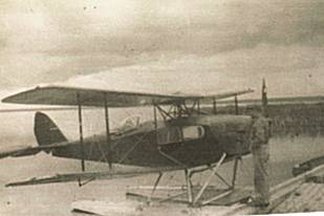 Our
Company rented a 1928 Fox Moth for our use for the summer. It was sitting
out at Cooking Lake and Garth was to fly it. Garth and I, plus a load of
Company gear, were to fly to Fort McMurray, and then to Goldfields, Athabaska.
It was a warm, calm, day and we make our take-off run down the lake. About
a hundreds ducks start flapping along with us. At the other end of the
lake the ducks are airborne, we are not. Again we tried to take off, with
the same results. The next day I remain on the dock and Garth takes off
with the equipment. The aircraft’s registration was CF-DIT. so we called
her Dit, like you would a faithful dog.
Our
Company rented a 1928 Fox Moth for our use for the summer. It was sitting
out at Cooking Lake and Garth was to fly it. Garth and I, plus a load of
Company gear, were to fly to Fort McMurray, and then to Goldfields, Athabaska.
It was a warm, calm, day and we make our take-off run down the lake. About
a hundreds ducks start flapping along with us. At the other end of the
lake the ducks are airborne, we are not. Again we tried to take off, with
the same results. The next day I remain on the dock and Garth takes off
with the equipment. The aircraft’s registration was CF-DIT. so we called
her Dit, like you would a faithful dog.
Later Garth appears. He has force landed in a farmer’s
slough between Edmonton and Lac Labiche. The next day we have Dit’s tail
tied to a stump. When Garth got the throttle to full power, we cut the
rope. Dit was off, leaving us standing in the swamp with the gear to carry
out.
With all our grub and gear we take the train to Fort McMurray
and settle down in a hotel. The hotel owner joins us for beer and complains
that there are large amounts of oil in the sand, but nobody is doing anything
about it. Finally, with the aid of a Beaver aircraft, most likely piloted
by the well known chap “Lefty” McCleod, we were landed on a rocky point
in Mickey Lake, well North of Beaverlodge Lake. We had a big supply of
canned goods, no knives, forks, or spoons, no sleeping bags, no tents,
and no bug repellent. I just can’t fully describe that first night. The
mosquitoes had a great time. However, we soon had a nice camp and mooring
dock set up. Garth came tootling in with Dit.
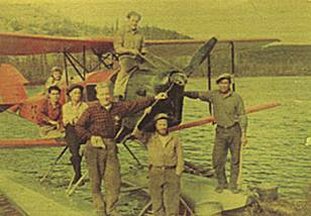
Joe on the nacelle
Garth on the float (left)
Don Macfie hanging onto the prop.
|
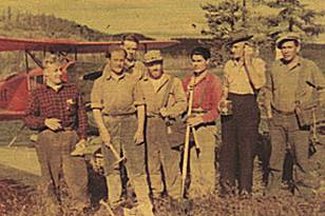
In front L to R – Garth, Joe, Don, with Dit
and some Natives in Northern Saskatchewan.
.
|
Things were just ideal, nice long sunny days, good fishing,
exercise with the Geiger counter over hill and dale, and Dit to carry us
to other lakes from which to work.
One day Garth took Dit to Goldfields for fresh supplies.
It was a nice morning when he took off however, about mid-afternoon, Garth
came staggering into camp, exhausted and eaten by flies. He announced that
Dit had taken a belly-ache about halfway out and was down in a small lake
with a broken rocker arm. Someone would have to go overland 25 miles to
Uranium City to radio out for repairs.
Jack said he would take a compass and go, then he pointed
at me and said, “I’ll go with him.” I told him I travelled best in bare
feet, and that’s the way I went through the jack pine bush. At fading
light we were sliding down a steep gravel bank into Uranium City. Next
day it was back to camp in the comfort of Lefty MacCleod’s Beaver. Within
a few days Dit was back at the dock. When we started brushing snow off
Dit’s wings we decided it was time to head for the “outside”.
The following summer Joe and I return, but without Garth.
He got flying Harvards with 400 Squadron out of Toronto and, one Sunday
morning, on the way to Trenton for an exercise, he collided with another
Harvard and went in. To bad, he was a nice chap, age 29, with wife and
children.
Dit was hired out to another Company further North and
took another belly-ache. With no lake or slough to jump into, she ended
up a heap of junk in the bush. No doubt she is there to this day. Joe and
I stayed on for the third season, then Joe was made Supplier of Needs for
the eight parties out in the bush. Joe became known as “The Expediter”.
After eleven years of adventure, I married locally, took
up pitching hay and sheaves, from where I had left off in 1940. Under the
VLA Act I took over the Macfie Homestead and continued there for the next
45 years of my working life.
And Joe? Well he started raising grub-stakes, and for
the next twenty-five years, prospected on other peoples money. Joe became
well known among the mining fraternity as “Barren Lands Joe”.
Ed. Don certainly struck a nerve. How did
wartime service effect your post war years?
One of my Skippers flew for a commercial carrier.
In 1954 he disappeared over Labrador. Another Skipper tried to go back
to DVA School, but the classroom was in a hangar with windows overlooking
the active runways. He said whenever a plane took off or landed, his whole
being was flying it, making it impossible to concentrate on the lesson
at hand. Some, because of the addiction to flying, became airport bums
hanging out at flying club coffee rooms. Others decided civilian life was
not for them and went back into the Service. Some mothballed their emotions
and memories, confiding in no one.
Drop us a line regarding how wartime experiences effected
your re entry into civilian life.
A Trip of Remembrance
Story and photos by John J. Chalmers, Edmonton AB
johnchalmers@shaw.ca
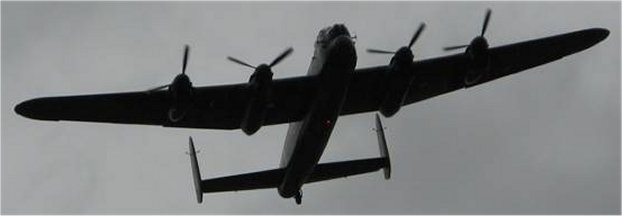
Battle of Britain Memorial Flight Lancaster, flypast
at Ludford, Lincolnshire, September 2, 2007
On September 1 and 2, 2007, my wife Linda and I
attended the Royal Air Force 101 Squadron Association 29th annual reunion
in England, which was also the occasion to mark the 90th anniversary of
the Squadron's formation. During the Second World War, the Squadron
was based in Lincolnshire, and today is at RAF Brize Norton. Although the
Squadron has not operated continuously for 90 years, it has served with
distinction in two World Wars, the Falklands conflict, the Gulf War, Afghanistan
and Iraq.
See http://www.raf.mod.uk/structure/101squadron.cfm
for info on 101 Squadron.
My interest derives from the fact that F/S Alfred
Reid Chalmers, a Lancaster navigator with the Squadron was killed along
with the seven other crew members on the return flight of a bombing raid
to Stettin. He was an uncle I never had a chance to know, and is buried
with the crew at Dejberg, Denmark. See that story at http://members.shaw.ca/johnchalmers/LM479/
RAF 101 Squadron suffered the highest losses of
any squadron in Bomber Command, losing 1,176 aircrew killed in action,
and yet at the end of the war it was still the largest operational squadron
in the RAF. Even with the passing of 26 members of the Association over
the past year, the 2007 reunion saw a record 151 people registered. We
had the opportunity to meet with current members of the squadron and several
veterans who served with it during the Second World War; and they had amazing
stories to tell.
One veteran we met is Royston Clarke, a wireless
operator with 101 Squadron. We sat with him and his wife, Diane, at the
dinner. At 18 years old, on his last training flight in a Wellington, the
aircraft crashed and he was one of only two survivors in the crew of five.
He had such serious damage to his face that he underwent serious plastic
surgery and was hospitalized for seven months. You'd never know to look
at him that he had such injuries. Then on his last operational flight in
a Lancaster, on his 30th trip to complete a tour, the aircraft crashed,
and again he was one of only two survivors, evading capture till the end
of the war. Royston still remembers Morse code and says sometimes as he
is driving he translates the road signs to Morse! He pointed to the letters
on Linda's name tag and read her name in Morse -- dit dah dit dit, dit
dit, dah dit, dah dit dit, etc.!
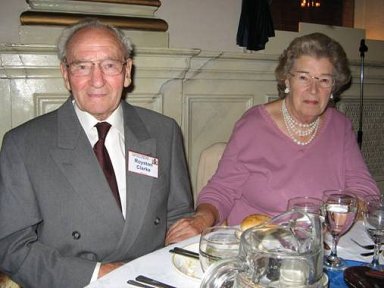
RAF 101 Squadron veteran Royston Clarke and his wife
Diane
101 Squadron was a “special operations” squadron.
Normally a Lancaster had a crew of seven. The Lancasters flown by 101 Squadron
carried an eighth crew member, a special wireless operator, who had to
know the German language, and whose duty it was to use special equipment
to listen in to German aircraft
radio transmissions and jam the frequencies
on which they were broadcast.
Another veteran we met served as one of those special
operators. He is Sam Brookes, who has since provided me with a description
of his duties and the equipment carried by 101 Squadron Lancasters which
enabled him to do his job. Sam says that, “The Germans tried all manner
of techniques to overcome the jamming, including having their instructions
sung by Wagnerian sopranos to try and fool our operators into thinking
it was just a civilian channel!”
The lunch in Lincoln on September 1 was followed
by the AGM of the Association, and a dinner was held in the evening. The
location of those events was at the Assembly Rooms, right near the magnificent
Lincoln Cathedral and the ancient Lincoln Castle in the heart of the city.
On Sunday, September 2, many gathered in the pubs at the small village
of Ludford for lunch before going to the village church for the annual
memorial service. Following that, the squadron's colors were paraded to
the memorial marker nearby for the laying of wreaths.
After the squadron’s colours were paraded and wreaths
were laid, tea and pastries were served at the Village Hall. The afternoon
concluded with a flypast of the Battle of Britain Memorial Flight Lancaster,
PA474. I saw the Lancaster fly again at Duxford when we visited there,
and we also saw the Lancaster in the BBMF Hangar at RAF Coningsby.
On September 3, I visited the site where the Ludford
Magna wartime base of RAF 101 Squadron was located, adjacent to the village
of Ludford. Today the buildings are gone, the land has been returned to
farming, and a tractor was busy cultivating the fields after the crops
had been taken off. All that remains are concrete roads leading into the
former site, and a road running through the fields. Nearby, close to the
village of Binbrook, the hangars remain from the time when the squadron
was located there from 1946-1957.
Our trip also included visits to the Royal Air Force
Museum in London, the Battle of Britain Memorial Flight at RAF Coningsby,
and the splendid aircraft displays at the Imperial War Museum, Duxford.
As well, prior to the 90th anniversary weekend, we took the Eurostar train
under the English Channel to Lille, France. There we rented a car the next
day for a trip to the Vimy Ridge Memorial. We also stopped at the Belgian
city of Ypres, and a few military cemeteries near Ypres, including the
Tyn Cot Cemetery, close to Passchendale and the largest Commonwealth cemetery,
with nearly 12,000 graves. Of those, the headstones mark the graves of
70% of men buried there whose remains are unidentified.
Sightseeing in London included Buckingham Palace
and the Royal Mews, the British Museum, the National Gallery and St. Paul's
Cathedral. Other sights included Lincoln Cathedral, Lincoln Castle, Norwich
Castle, some of the coastline and palatial homes and gardens, including
another royal residence, Sandringham. We drove 251 km on the right side
of the road with a rental car in France and Belgium, and 940 miles on the
"wrong" side of the road in England, shifting a 5-speed manual transmission
with my left hand!
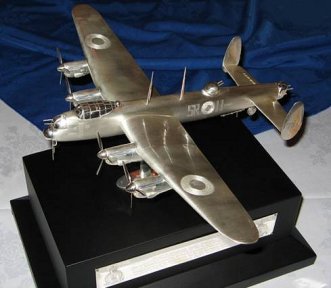
The Silver Lancaster
I have posted 30 photos of the 101 Squadron weekend,
photos from Vimy Ridge, hangars at Binbrook which are still in use for
industrial purposes, and a picture of the silver Lancaster shown at the
banquet. It was commissioned by RAF 101 Squadron Association to mark the
90th anniversary. It is about a 12-14" long and is a unique creation for
display at formal dinners. The aircraft depicted is Lancaster DV302, SR-H
of 101 Squadron, which completed 121 bomber operations during the War.
The photos can be seen at http://photoshare.shaw.ca/gallery/johnchalmers
At that location, click on "A Trip of Remembrance
2007" to bring up the photos. Click on any photo to see a larger size or
click "View Show" to run the photos as a slide set. While you're at the
gallery, you can click on any title to see the other photo shows.
I have also posted a two-minute and 37 second movie
of images and footage of the memorial events held at Ludford on September
2. For reasons unknown to me, the video seems to lose a bit of the color
saturation when posted, but it is still legible. The flypast of the Battle
of Britain Memorial Flight Lancaster is taken from footage shot at Ludford
and at Duxford. A picture the BBMF Lancaster in the hangar at Coningsby,
is shown at the end of the video. You can see the video by going directly
to http://videomail.shaw.ca/view/7938524494-1190293899-82549/79385
I have also posted the Lancaster flypast only (1
minute) at YouTube, which can be seen at
http://www.youtube.com/watch?v=fgK8fnm91X4
Below is a photo which I have not posted at the
web site. It is of the Battle of Britain Memorial Window in the RAF Chapel
at Westminster Abbey. Four airmen are depicted in the stained glass images.
If you would like more information, also below are links to some of the
sites we visited.
Cheers,
John Chalmers
Royal Air Force Museum, Hendon (greater London area) --
www.rafmuseum.org.uk/london/index.cfm
Battle of Britain Memorial Flight -- http://www.bbmf.co.uk/
Imperial War Museum, Duxford -- http://duxford.iwm.org.uk/
Vimy Ridge Memorial --
http://www.vac-acc.gc.ca/remembers/sub.cfm?source=memorials/ww1mem/vimy
http://www.vac-acc.gc.ca/remembers/sub.cfm?source=history/firstwar/vimy/vimy7
http://www.civilization.ca/cwm/vimy/index_e.html
http://www.civilization.ca/cwm/vimy/sculptures_e.html
Tyn Cot Cemetery -- http://www.firstworldwar.com/today/tynecot.htm
and
http://www.vac-acc.gc.ca/remembers/sub.cfm?source=memorials/othermem/tyncot
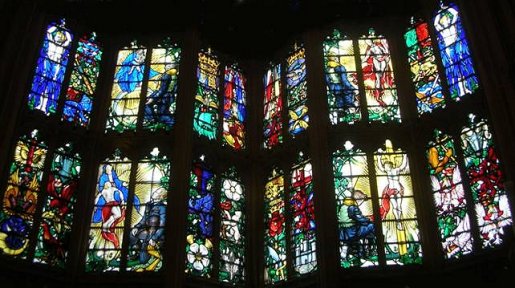
Battle of Britain Memorial Window in the RAF Chapel
at Westminster Abbey
Official Order to Aircrew personnel
If you are shot down over enemy territory, and survive,
it is your duty to make every effort to escape capture and return to base.
If captured take advantage of every opportunity to escape.
This was part of OTU training. Some training bases carried
out mock escape practices in cooperation with the local constabulary. Aircrew
were bussed into the countryside at night and ordered to avoid capture
and return to base.
There is an interesting story of two Canadians on such
an exercise who, when crossing a narrow bridge, were confronted by a local
police officer who tried to take them into custody. One of the Canadians
decked the poor officer. They rolled him into the ditch and made their
way safely back to base. By the time the complaint was filed by the constable,
the Canadians had been posted to a Squadron.
Aircrew were given escape kits containing, among other
things, maps, secret compasses, chits to obtain assistance. Compasses were
hidden in items such as buttons, pens, pencils, razorblades.
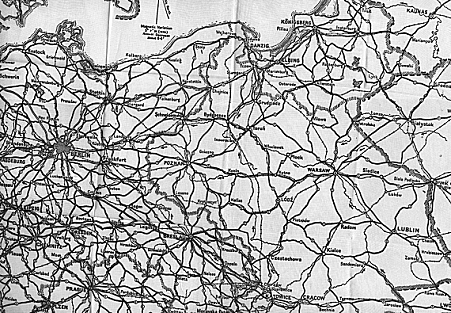
Part of 45cm x 37 cm silk escape map. Berlin
Left Centre
Blood Chit
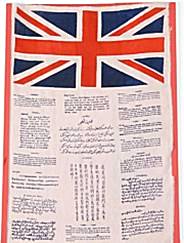 Blood
Chit wording
Blood
Chit wording
Dear friend
I am an Allied fighter. I did not come here to do
any harm to you who are my friends. I only want to do harm to the Japanese
and chase them away from your country as quickly as possible. If you will
assist me, my Government will sufficiently reward you when the Japanese
are driven away.
Languages: French, Tamil, Sumatra, Thai,
East Shan and North Thai, West Shan, English, Jawl, Chinese, Haka,
Kagmin, Laizo, Bengali, Annamite, Burmese, and Karen
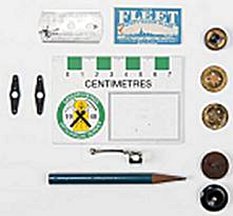
Compasses
Richard Bennett was kind enough to photograph these items
from his collection for use in our newsletter.
Rick Bennett (email: pegasus@sasktel.net
phone: 306-545-0217)
researcher and collector of WWII 1st Canadian Parachute
Corps, First Special Service Force, and escape-evasion items).
Ted Hackett
IAero-News has learned remains discovered last year of
the aircrew from a WWII RAF Halifax bomber -- shot down over Poland in
August 1944 while on a special operation at the time of the Warsaw Uprising
-- will be buried with appropriate military honors in Krakow, Poland on
Thursday, October 4.
The service, which will be attended by family members
of the crew, will take place during the anniversary week marking the end
of the Warsaw Uprising, which concluded in October 1944.
The Ministry of Defense says that the Halifax, manned
by a mixed British, Canadian and Irish crew, was on route from Brindisi
in Italy to drop supplies at a location 60 kilometers southeast of Warsaw
when it was shot down by an enemy fighter close to the town of Dabrowa
Tarnowska, approximately 110 kilometers east of Krakow.
On October 4, a memorial service will take place in the
Garrison Church in Krakow, followed by the rededication service, which
will take place in the Commonwealth War Graves cemetery within Krakow's
Rakowicki Cemetery. The rededication will involve personnel from the RAF's
Queens Colour Squadron and the Canadian Forces, as well as the families
of the crew.
Halifax JP276, from 148 Squadron, took off from Brindisi,
Italy at 19:56 hours on 4th August 1944 to carry out a special operation
over Southern Poland. From the time of take-off nothing further was heard.
On board were Flight Lieutenant Arnold Raymond Blynn,
RCAF Pilot; Flying Officer Harold Leonard Brown, RCAF Wireless Operator;
Pilot Officer George Alfred Chapman, RCAF Navigator; Flight Sergeant Arthur
George William Liddell, RCAF Air Gunner; Flight Sergeant Charles Burton
Wylie, RCAF Bomb Aimer; Sergeant Kenneth James Ashmore, RAF (VR) Air Gunner;
and Sergeant Frederick George Wenham, RAF (VR) Flight Engineer.
Eyewitnesses later said the aircraft experienced problems
near the town on Dabrowa Tarnowska, and was on fire and flying in the direction
of the village of Morzychna. The aircraft was seen to suddenly stop in
mid-air before crashing, killing all seven crew members.
Due to the presence of occupying enemy forces the remains
that were discovered at the time were buried in secret in the town of Dabrowa
Tarnowska. These remains were later exhumed and reburied in the Krakow
Rakowicki Cemetery.
In 2006, a Polish team from the Rising Museum in Warsaw
located remains at the crash site on the outskirts of Dabrowa Tarnowska.
In October 2006 the site was excavated and aircraft wreckage and artefacts
belonging to JP276 were recovered. During the excavation human remains
were recovered.
In accordance with Ministry of Defense policy and the
wishes of the families the remains will be buried in a single casket/ossuary.
The crew of Halifax JP276 are commemorated on the Runnymede memorial, which
overlooks the river Thames on Cooper's Hill, Englefield Green.
BOOK REVIEW
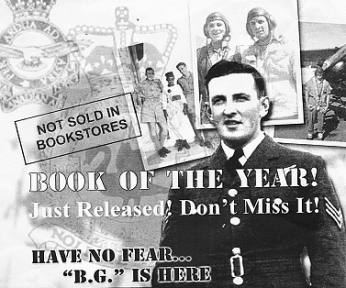 HAVE
NO FEAR … “B.G.” IS HERE By B. Graham McDonald
HAVE
NO FEAR … “B.G.” IS HERE By B. Graham McDonald
191 pages, soft cover, 8 ½ X 11 60 photos
ISBN 978-0-9784242-0-6
Order from Author
B. Graham McDonald,
507 – 165 Herchimer Ave.
Belleville, ON. K8N 5M1
Cost $20.00 plus $7.00 Handling and Postage. Enclose cheque
or M/O.
Graham was a member of The Air Gunner’s of Canada Association,
No. 170.
As Editor of Short Bursts I have reviewed many
books written by Ex- Service Personnel reminiscing on their experiences
during WW II. Many fall into a lock-step rendition of postings, dates,
Squadrons, aircraft, and tend to lose reader interest. Not so with HAVE
NO FEAR "B.G." IS HERE. This greeting was belted out by Graham when entering
the mess, barrack block, or pub. I have never experienced a book that,
on just about every page, has one erupting in laughter, or pausing to reflect,
‘that reminds me of a similar situation.’ Ex Aircrew can certainly identify
with Graham’s experiences. He spares no one, the pre war personnel on training
bases, who found themselves suddenly elevated to positions of power and
authority over raw aircrew trainees destined for the uncertainty and trauma
of war, by-the-book administrative officers, or mess hall catering staff
siphoning off rations for self gain, being relegated to the inferior position
of Colonials by some RAF personnel, all come under the scrutiny of the
authors caustic quill.
From the time Graham enlisted in 1940, it took four years
for him to be posted to an operational Squadron. In those four years there
was a lot of down time. Trained as a WAG under the CATP, he bounced around
RAF training Units in the UK, toured North Africa as crew member on a Wellington
torpedo bomber, moved from one non operational holding unit to another,
then by boat back to the UK. Finally he was posted to 103 Squadron RAF,
where he completed his tour of 31 Operational missions.
The writer does not gloss over the down time but goes
into detail regarding their shenanigans. After all, idle hands are the
Devil’s instruments. When he begins Operational flying with 103 Squadron,
Graham , then a WO1, explains their crew’s actions that enabled them to
beat the odds and complete their tour, included some of the crew baling
out close to London. Even the description of this dicey situation is laced
with humour.
Historians will gain greatly from the explanation of defying
the odds during operational flying. Baby Boomers will realize the life
style and trauma experienced by family service members. And, dear reader,
you and I, ex-aircrew, can enjoy identifying with, and appreciating the
humour of this timely work.
Graham tells it as it was. I recommend it highly.
Reviewed by John Moyles.

Graham and Connie on their 60th. Anniversary September
11, 2006
Thank you for this book Graham and Connie.Our heart
felt congratulations.
CORRESPONDENCE
Re: Sgt. Scratch Story Sept issue Short Bursts
I simply want to compliment you for the above story, which
from my knowledge is most accurate. Don was a good buddy of mine in high
school in the hamlet of RADWAY in northern AB. He then used his step-father's
name, WHITMAN.
I remember seeing him off to join the RCAF and seemingly
a short time later appearing as a sharp looking Sgt-Pilot. This was a factor
in my joining in Aug 1941, I think.
Incidentally, my brother and his wife attended Don's funeral
in ASHMONT, AB. Many thanks again.
Harold Park Wartime Aircrew
Kelowna BC solhar@shaw.ca
Hi John,
Summer is just about over and I expect you’ll be collecting
more stories for “Short Bursts”. I have been corresponding with Harry Levy
(RAAF navigator) who was based at RAF Alness during 1944 and flew in Sunderlands.
You or my father may have shared a pint with him in the mess one evening.
While he was not an air gunner, the whole crew obviously shared the experiences
and you may find his two stories of interest.
He shares a bit of information about himself then tells
the story about “A Day of Operational Flying” that stretches over four
days from November 26th to 29th in 1944. It commences with the crash of
my fathers Sunderland and Harry’s experiences over the next few days. The
story is a bit long and I’ve edited it slightly from his original version.
You have his permission to use it if you wish.
The second story takes place a month earlier when they
pass a flight of Lancaster Bombers over the North Sea and his meeting with
one or their crew members 50 years later.
Regards,
David Kinton kinton@jacos.com
Ed: Harry’s articles are too long to reproduce in
Short Bursts, but if any of you Coastal types out there are interested
in reading Harry Levy’s accounts of Operational flying, drop me a line
and I will get a copy to you. They are well written and very descriptive.
Letter from Down Under
Ed. In the June 2007 Page we ran the following letter
from Ken Wright of Australia:
I am writing an article about an Australian airman, A.
Heymanson, who trained as a Wireless/Air gunner at Mossbank
- Saskatchwan, Canada as part of the British Commonwealth Air Training
Plan in 1943.
Could I please ask for your help. I am looking not for
the history of the gunnery school but the actual mechanics of the training.
Windage, fall of shot, deflection etc. In other words, how to shoot. Sgt
A. Heymanson eventually joined 195 Sqn as a top turret gunner in a Lancaster.
May I please ask if you can direct me to an internet site
or any other source where I might find the relevant information. Any assistance
you can give will be most appreciated.
Kindest regards,
Ken Wright.
wright9w@optusnet.com.au
Ed. Later, In my reply to Ken asking him if he had
any feed-back, he replied in the negative. We mailed Ken a copy of Short
Bursts #60 Dec. 1997, which contains a lengthily article on #2 B&G
Mossbank. Here is his reply.
Hi John,
Thanks very much for the copy of ''Short Bursts'. Arrived
this morning. I will post back tomorrow. I've attached a draft copy of
the story. Would you do me the honour [or do you spell it 'honor'] of pulling
the story apart a with a critical editors eye and tell me if I've made
any mistakes, and any suggestions, additions, subtractions etc. Please
be as critical as you like or feel free to praise it. I love flattery.
The article's central character is WO Heymanson who gets only brief mentions
as this is all the personal information I could get from his son.
Enough waffle-Hope you like it.
Best wishes,
Ken.
Ed. This will give you, our readers, a brief glimpse
of how our Newsletter is providing information around the world. If you
can assist any of those who are seeking information, don’t hesitate to
contact the enquirer. The results are quite rewarding.
Ted Hackett
Change of Name for the RCAF Memorial Museum
Hello Ed and Bruce
Got your name from Barbara Adkins and she suggested that
you may be able to pass this to members of the Canadian Military Photographers
Association. Would appreciate your help.
As you are probably aware by now, the name change of the
RCAF Memorial Museum was approved, without consultation with any of those
concerned and in the face of considerable opposition. The changes are already
underway; i.e. the web site, and are to be completed by 01 APR 08 (very
ironic).
However, some of those who are opposed have formed a small
committee whose purpose is to get enough support to have the name change
reversed or reach a compromise which would see the RCAF retained in any
new name.
Support is growing, not only in the number who have signed
the original petition (nearly 900) but by individuals who have written
letters or e-mailed the museum.
We, the committee, are sending out the attached letter
to as many interested parties as possible and hope to generate a large
number of letters and/or e-mail to the Board of Directors and at least
get a compromise name as is mentioned in the letter. We would appreciate
your help in informing as many people as possible about our aim to get
the name change reversed.
Per Ardua Ad Astra
Committee,Keeping the Name
"RCAF Memorial Museum"
The attached letter referred to above
August 20, 2007
Re: RCAF MEMORIAL MUSEUM NAME CHANGE
On May 12, 2007, an e-mail message was sent to sixteen
members of the RCAF Board of Directors asking them to vote on the following
motion:
“The name of the Museum located at 8 Wing Trenton, is
the “National Air Force Museum of Canada”, hereinafter referred to as the
“Museum” and that the name of the Airpark is “The RCAF Memorial Air Park”.
Changes in Museum operations affected by this decision
are to occur gradually over time but all signage and other supporting documents
will be in place reflecting this name change no later that 1 April 2008.”
Upon receiving a copy of this e-mail, letters from volunteers
were written and hand delivered to the Chairman of the Board expressing
objection to this motion. An e-mail was sent with a copy of one of the
letters to other interested parties asking for support through a petition.
The petition has to this date, 876 names from across Canada, Mexico, the
USA and Europe. The names on the petition, include retired RCAF and CAF
(from LAC to LGen) as well as presently serving CAF personnel and civilians.
The motion was passed without any input from the volunteers, the Ad Astra
Stone group or the Halifax Restoration crew. A briefing was called on Friday,
June 1st to inform the volunteers after the name change had been announced
on the local radio stations. The briefing was given by the Executive Director;
the Chairman of the Board was present, however, he did not address us.
A committee has been formed to clear up misconceptions
re the name change that have been given to the media and to convince the
Board to reconsider the motion. We do not object to the museum being called
“National Air Force Museum of Canada” as an additional name as long as
the RCAF Memorial Museum name is retained as the official name on the front
of the building and on all signage, stationery and daily operation of the
Museum. As you see in the motion, the date for replacing the name is April
1st, 2008, which means for 10 months they are continuing to use the RCAF
Memorial name. The visitors to the Museum are unaware of the name change
and continue to think they are supporting the RCAF Memorial Museum. Even
though the Air Park retains the RCAF acronym any revenue from the purchase
of stones will be to the benefit of the National Air Force Museum of Canada.
We feel this is misleading.
The artifacts in the museum should encompass everything
from the first military flying in Canada to the present and on into the
future. The RCAF era forms a large amount of this history and that is why
we want the name preserved. There are many Air Force Museums in Canada
but we believe it is the acronym “RCAF” that attracts so many visitors
to the Museum in Trenton. At least three generations of ex- RCAF veterans
have donated monies and artifacts specifically to the RCAF Memorial Museum.
It is a disservice to these people to change the name.
We encourage all concerned members to discuss this situation
within their own organizations and support the retention of the name “RCAF
Memorial Museum”. One dissenting e-mail or letter will not cause the Board
to change their decision, but many might. If you agree with us, please
send a letter to Board of Directors, RCAF Memorial Museum, PO Box 1000,
Stn Forces, Astra ON K0K 3W0 or e-mail your individual views to the Chairman
of the Board, Peter McCulloch, at peter.mcculloch@sympatico.ca and/or to
the Executive Director, Chris Colton, at director@rcafmuseum.on.ca
with a carbon copy to our committee, if you wish, at RCAF.NameChange@canada.com.
Several volunteers have left the museum and many people
have withdrawn their financial support and donations of artifaxes. If we
are to continue to have a Memorial Museum that perpetuates the RCAF name,
we need your support now.
Per Ardua Ad Astra,
Committee,
Keeping the Name
“RCAF Memorial Museum”
Search Pattern
From: "Weldon Moffatt" <rweldon.moffatt@sasktel.net>
To: "Doug Sample" <dsample@videotron.ca>
Cc: "John Moyles" <moyles@accesscomm.ca>
Sent: Wednesday, August 29, 2007 11:51 AM
Subject: Re: HELP
Doug Sample wrote:
Dear Weldy,
We have lost the trail of two of our YAM Life Members.
Florence & Robert McWhirter's last address was 312-1040 Ist Street
East, Prince Albert Sask. S6V 0C4 Phone # was (306)764-8784. Last contact
was Feb 2000.
Tried to find them via Google but no luck...seem to have
vanished.. Bob was an Air Gunner with 420 Sqn Ist tour and 405 PFF
for seccond tour. Total ops - 58 all with the same original Jeff Coffey
crew. Any chance you could track them down....strange BOTH would vanish
together in such a short time.
Best regards to you and Alma. Cheers, Doug.
Doug
So far have checked telephone and it is still active but
nobody answered. There are no other WcWhirters in Prince Albert.
Have checked the obituaries and no listing for that name in last six years.
Weldy
Ed. Can anyone help Doug Sample?
Ed Chenier deed2ed@shaw.ca
LAST BOMBING MISSION
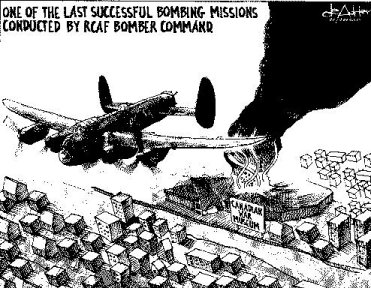
A Picture is worth a thousand words
Canadian Lanc from 6 Group, Bomber Command, delivers final
strike in recent skirmish. Pinpoint bombing eliminated propaganda output
centre while leaving building intact. Collateral damage: Two civilians,
B Oda and J Guerts.

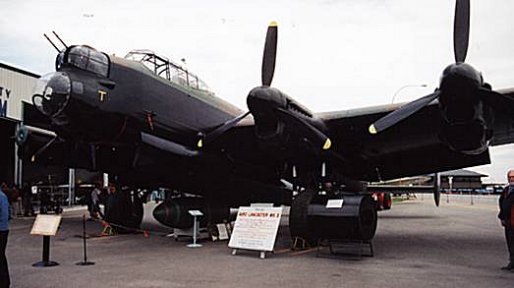
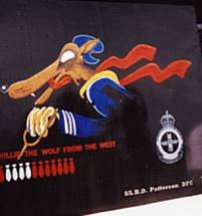 During
the lunch a replica of the nose art of "Willie the Wolf" of 426 Squadron
and the nose art of W/C McCarthy's aircraft were unveiled. A small
framed reproduction of the McCarthy nose art was presented to his son Joe
McCarthy Jr. who was present with his family.
During
the lunch a replica of the nose art of "Willie the Wolf" of 426 Squadron
and the nose art of W/C McCarthy's aircraft were unveiled. A small
framed reproduction of the McCarthy nose art was presented to his son Joe
McCarthy Jr. who was present with his family.
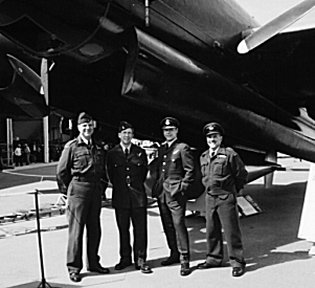 .
.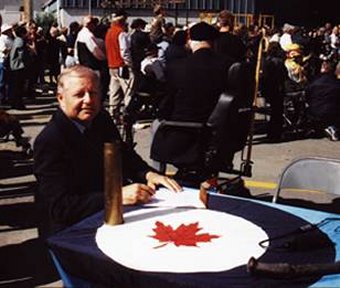
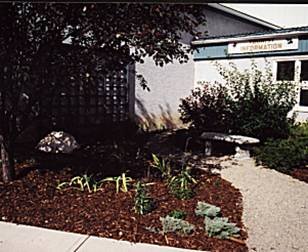
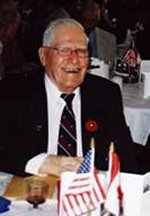
 Our
Company rented a 1928 Fox Moth for our use for the summer. It was sitting
out at Cooking Lake and Garth was to fly it. Garth and I, plus a load of
Company gear, were to fly to Fort McMurray, and then to Goldfields, Athabaska.
It was a warm, calm, day and we make our take-off run down the lake. About
a hundreds ducks start flapping along with us. At the other end of the
lake the ducks are airborne, we are not. Again we tried to take off, with
the same results. The next day I remain on the dock and Garth takes off
with the equipment. The aircraft’s registration was CF-DIT. so we called
her Dit, like you would a faithful dog.
Our
Company rented a 1928 Fox Moth for our use for the summer. It was sitting
out at Cooking Lake and Garth was to fly it. Garth and I, plus a load of
Company gear, were to fly to Fort McMurray, and then to Goldfields, Athabaska.
It was a warm, calm, day and we make our take-off run down the lake. About
a hundreds ducks start flapping along with us. At the other end of the
lake the ducks are airborne, we are not. Again we tried to take off, with
the same results. The next day I remain on the dock and Garth takes off
with the equipment. The aircraft’s registration was CF-DIT. so we called
her Dit, like you would a faithful dog.







 Blood
Chit wording
Blood
Chit wording

 HAVE
NO FEAR … “B.G.” IS HERE By B. Graham McDonald
HAVE
NO FEAR … “B.G.” IS HERE By B. Graham McDonald

